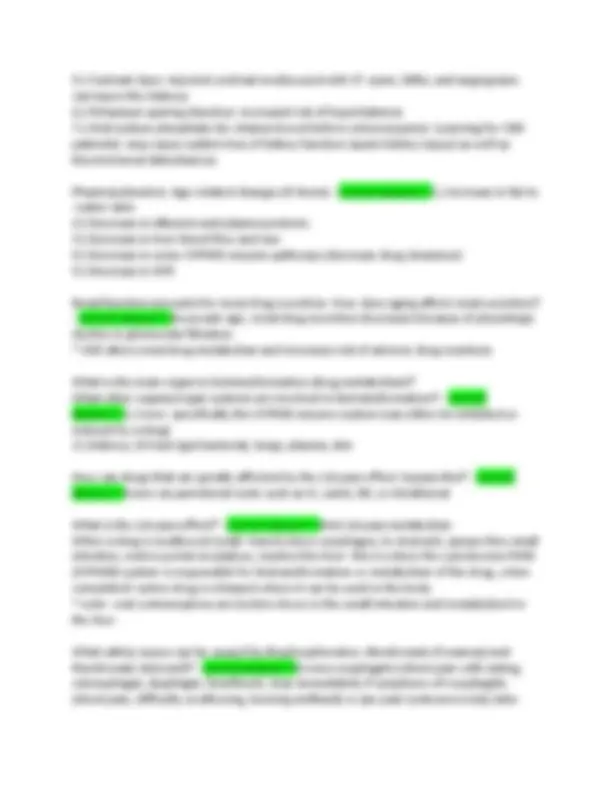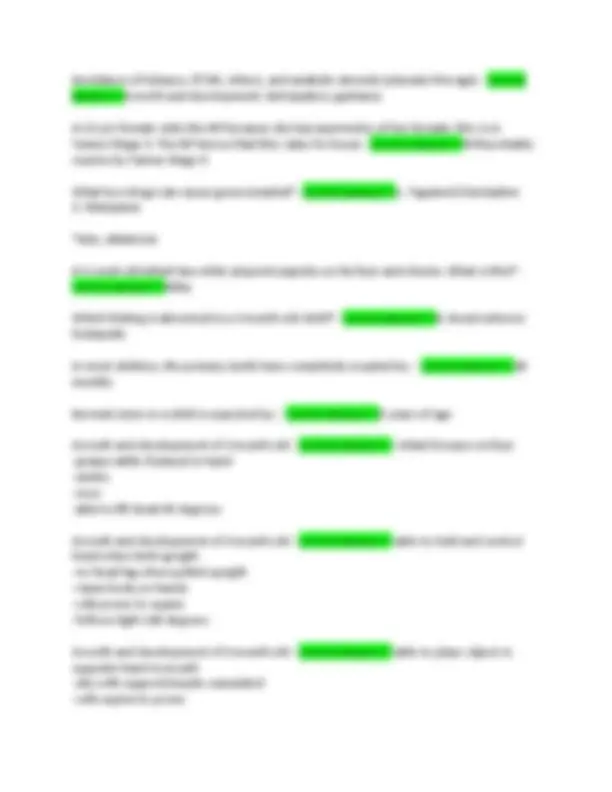














Study with the several resources on Docsity

Earn points by helping other students or get them with a premium plan


Prepare for your exams
Study with the several resources on Docsity

Earn points to download
Earn points by helping other students or get them with a premium plan
Community
Ask the community for help and clear up your study doubts
Discover the best universities in your country according to Docsity users
Free resources
Download our free guides on studying techniques, anxiety management strategies, and thesis advice from Docsity tutors
What are the safety issues caused by taking Phenytoin (Dilantin)? - correct answer>>1.) Earliest sign of toxicity: horizontal nystagmus and unsteady gait 2.) If severe, slurred speech, lethargy, confusion, and coma 3.) monitor blood levels 4.) can also cause gingival hyperplasia BEERS Criteria: Medications that should be avoided in patients over 65 years? - correct answer>>1.) 1st generation anti-histamines (diphenhydramine, doxylamine, chlorpheniramine) 2.) Anti-psychotics: Quetiapine, Clozapine, Pimavaserin (use with caution) 3.) Rivaroxaban & Dabigatran- Increased risk of bleeding 4.) Tramadol- risk of hyponatremia from syndrom of inappropriate antidiuretic hormone secretion 5.) Opioids- do not combine with BZDs or Gabapentinoids- will induce respiratory depression What safety issues can occur when taking atypical antipsychotics such as: Risperidone (Risperidal), Olanzapine (Zyprexa), and Quetiapine (Seroquel)? - correct answer>>- High
Typology: Exams
1 / 20

This page cannot be seen from the preview
Don't miss anything!













What are the safety issues caused by taking Phenytoin (Dilantin)? - correct answer>>1.) Earliest sign of toxicity: horizontal nystagmus and unsteady gait 2.) If severe, slurred speech, lethargy, confusion, and coma 3.) monitor blood levels 4.) can also cause gingival hyperplasia BEERS Criteria: Medications that should be avoided in patients over 65 years? - correct answer>>1.) 1st generation anti-histamines (diphenhydramine, doxylamine, chlorpheniramine) 2.) Anti-psychotics: Quetiapine, Clozapine, Pimavaserin (use with caution) 3.) Rivaroxaban & Dabigatran- Increased risk of bleeding 4.) Tramadol- risk of hyponatremia from syndrom of inappropriate antidiuretic hormone secretion 5.) Opioids- do not combine with BZDs or Gabapentinoids- will induce respiratory depression What safety issues can occur when taking atypical antipsychotics such as: Risperidone (Risperidal), Olanzapine (Zyprexa), and Quetiapine (Seroquel)? - correct answer>>- High risk of weight gain, metabolic syndrome, and type 2 diabetes
alone upon awakening with 8-oz glass water (not juice) before breakfast; do not lie down for 30 minutes afterward; do not mix with other drugs What safety issues are caused by Stains: Atorvastatin (Lipitor), Lovastatin (Mevacor), Rosuvastatin ( Crestor), Simvustatin (Zocor), Fluvastatin (Lescol), Pravastatin (Pravachol), and Pitavastatin (Livalo)? - correct answer>>-Do not mix with grapefruit juice; drug- induced hepatitis or rhabdomyolysis higher if mixed with azole antifungals
What drugs are used to treat heart disease? - correct answer>>Cardiac Glycosides: Digoxin (Lanoxin) and Anti-coagulants What are the signs and symptoms of digoxin overdose? - correct answer>>1.) Initial symptoms are GI (nausea/vomiting), hyperkalemia, and bradydysrhythmias (atrioventricular [AV] blocks) or tachydysrhythmias (ventricular 64tachycardia/fibrillation or atrial tachycardia with 2:1 block). 2.) Others include confusion and visual changes (yellowish-green-tinged color vision). What labs are ordered for suspected digoxin toxicity? What is the treatment? Lab values? - correct answer>>■ Laboratory tests for suspected digoxin toxicity: Order a digoxin level, electrolytes (potassium, magnesium, calcium), creatinine, and serial EKGs. Treatment: Digoxin-specific antibodies are IgG antidigoxin antibodies that bind free digoxin in blood (Digibind, DigiFab). ■ Potassium values (adult to elderly): ● Critical: <2.5 or >6.5 mEq/L ● Normal: 3.5 to 5.0 mEq/L What drug class is recommended for treating, preventing, and reducing the recurrence of venous thromboembolism (VTE), which results in stroke, PE, or acute MI? - correct answer>>Anticoagulants What is the first line agent of anticoagulants for patients without valvular disease? - correct answer>>Direct oral anticoagulants (DOACs)- which do not require laboratory monitoring of INR and are not affected by Vitamin K in the diet What is the only type of chronic anticoagulant is recommended for patients with valvular disease or prosthetic heart valves? - correct answer>>Warfarin sodium (Coumadin) What drug is:
Contraindications for Vitamin K antagonist: Warfarin (Coumadin) in treating heart disease? (4 items) - correct answer>>1.) Large esophageal varices, 2.) thrombocytopenia 3.)recent eye/brain/trauma surgery, within 72 hours of major surgery, 4.) blood dyscrasias Careful if history of GI bleeding Contraindications for ACEIs: Enalapril (Vasotec) Ramipril (Altace) Lisinopril (Zestril) Captopril (Capoten), in treating heart disease? (8 items) - correct answer>>1.) Avoid mixing with potassium supplements or potassium-sparing diuretics 2.) Avoid in pregnancy, 3.) breastfeeding, 4.) aortic stenosis, angioedema, 5.)symptomatic hypotension, 6.)severe aortic stenosis, 7.) hyperkalemia 8.) ACEI cough: New onset of dry cough (not accompanied by upper respiratory infection symptoms), switch to an ARB or another antihypertensive drug class Contraindications for ARBs Candesartan (Atacand) Valsartan (Diovan), Losartan (Cozaar), in treating heart disease? (4 items) - correct answer>>1.) Avoid mixing with potassium supplements 2.) Do not combine ACEI with ARBs 3.) Lower incidence of cough compared with ACEIs 4.) Avoid in pregnancy Contraindications for Potassium-sparing diuretics Triamterene (Dyrenium) Triamterene + hydrochlorothiazide (Dyazide) Amiloride, (Midamor) Spironolactone (Aldactone), in treating heart disease? - correct answer>>Higher risk of hyperkalemia if combined with ACEI, potassium, or ARBs and with severe renal disease Diuretics may worsen urinary incontinence
Spironolactone: Avoid combining with ACEI, ARBs, high potassium diet/supplements, salt substitutes, chronic NSAIDs (risk of hyperkalemia); gynecomastia may occur; aldosterone antagonist activity Contraindications for Beta-Blockers Propranolol (Inderal) Atenolol (Tenormin) Metoprolol (Lopressor), Pindolol (Visken), in treating heart disease? - correct answer>>Contraindicated if patient has chronic lung diseases (asthma, COPD, emphysema, chronic bronchitis) Do not discontinue beta-blockers abruptly because of severe rebound (hypertensive crisis) Contraindications for Phosphodiesterase 5 (PDE5) inhibitors Sildenafil (Viagra) Tadalafil (Cialis) Vardenafil (Levitra), in treating heart disease? - correct answer>>Do not mix with nitrates (nitroglycerine, isosorbide dinitrate) and some alpha-blockers Erection >4 hours: Refer to ED Do not give within 3-6 months of a myocardial infarction or stroke Contraindications for SSRIs Citalopram (Celexa), in treating heart disease? - correct answer>>Avoid doses > mg/d; can prolong QT interval For patients >60 years of age, the maximum dose is 20 mg per day Routine vitamin K1 (Phytonadione) supplementation is not advised- what are the dietary issues of taking Warfarin (Coumadin)? - correct answer>>Patient should avoid excess intake of kale, spinach, collards/mustards/beet greens, and broccoli raab to prevent reducing the effect of Warfarin and decreasing INR *Note- mayonnaise, canola oil, and soybean oil also have high levels of Vitamin K Why should patients avoid drinking or limit alcohol to no more than 1-2 servings occasionally when taking Warfarin (Coumadin)? - correct answer>>increases risk of bleeding even if INR is in target range What is an adverse reaction of taking Warfarin (Coumadin)? - correct answer>>Purple toes syndrome- (Rare)- skin necrosis located in subcutaneous fat, breasts, extremities, trunk (within first few days of receiving large doses of warfarin), bleeding
Atrial fibrillation is categorized based on its duration (< 1 week, < 1 year, long-term, and refractory to treatment). Triggers include caffeine, stress, alcohol, and emotion. Patients with cardiovascular disease, history of cardiac surgery, hypertension, and diabetes are also at increased risk for developing atrial fibrillation. Typical treatment and treatment goal for afib? - correct answer>>achieve rate control, generally with beta blocker medication or CCB if untreated, risks include cerebrovascular complications and HF due to blood stasis in the ventricle and inefficient pumping leading to myocardial dysfunction Signs and symptoms of afib? - correct answer>>fast, irregular heartbeat, palpitations, anxiety, fatigue, SOB, possible syncope What cardiac phenomenon involves a narrowing at any portion of the aorta, but most commonly in the region of the ductus arteriosus (juxtaductal region). Freshly oygenated blood flows from the left ventricle and into the aorta but cannot reach the lower extremities. As a result of the obstruction, left ventricular afterload increases and this can lead to hypertrophy of the left ventricle and hypertension. - correct answer>>coarctation of the aorta Note: In all neonates, coarctation of the aorta leads to either left ventricular failure or insufficient cardiac output that cannot meet metabolic demands. Ultimately, once the ductus arteriosus functionally closes, perfusion to the lower extremities decreases and the lower body develops a pale coloration. While not the most common congenital heart defect diagnosed in the neonatal period, coarctation of the aorta is considered a cyanotic heart defect and requires intensive care and cardiology involvement. Any newborn who presents to an outpatient setting with a horizontal line of demarcation and a significant difference between upper and lower extremity mean arterial blood pressure readings or pre and post-ductal pulse oximetry readings requires an urgent transfer to the nearest emergency room. Prostaglandin E1 may be necessary to maintain ductal patency in the timeframe preceding primary repair. Describe aortic regurgitation murmur and where it is heard the best? - correct answer>>a high-pitched, blowing diastolic murmur with a decrescendo pattern typically heard best with the diaphragm of the stethoscope at the left sternal border Describe a mitral regurgitation murmur and where it is heard the best? - correct answer>>a high-pitched, holosystolic murmur, heard best with the diaphragm of the stethoscope at the apex
What are the systolic murmurs? - correct answer>>MR- mitral regurgitation PM-physiologic murmur AS- aortic stenosis MVP- mitral valve prolapse What are the diastolic murmurs? - correct answer>>AR- aortic regurgitation MS-mitral stenosis What are two main concerns for initiating statin therapy? - correct answer>>1.)acute drug-induced hepatitis 2.) rhabdomyolysis Note: monitor liver function closely Liver function must be closely monitored by drawing liver function tests (D) at baseline and at 12 weeks after beginning a statin. If a patient experiences jaundice, dark urine, gastrointestinal upset, or clay-colored stools, they should be advised to call their nurse practitioner immediately so these tests can be performed. Serum aminotransferases and bilirubin may be elevated. What conditions can a D-dimer level be elevated? - correct answer>>DVT kidney disease infection malignancy Note: D-dimer is a protein that develops in the blood when a clot is dissolved and a normal value is <500mg/L. Remember, a D-dimer level does not confirm DVT- you need a doppler US What Tanner stages does pubertal growth occur in girls? - correct answer>>Stage II-III What Tanner stages does pubertal growth occur in boys? - correct answer>>Stages III-IV What is the correct order of maturation in males? (growth and development) - correct answer>>pubic, axillary, and then facial hair What is the earliest secondary sexual characteristic in girls? (growth and development) - correct answer>>the onset of breast development
Avoidance of tobacco, ETOH, others, and anabolic steroids (educate this age) - correct answer>>Growth and development: Anticipatory guidance A 12 y/o female visits the NP because she has asymmetry of her breasts. She is in Tanner Stage 3. The NP knows that this: (also for boys) - correct answer>>Will probably resolve by Tanner Stage 5 What two drugs can cause gynecomastia? - correct answer>>1. Tagamet/Cimetadine
Anticipatory guidance for one month old - correct answer>>-do not place bottle in bed with baby
months and remember Hepatitis B is not given at 4 months, you have knocked out a lot of vaccines to remember. immune thrombocytopenia - correct answer>>In children, this is most often an acute episode following a viral infection. It is seen most frequently in children ages 3 to 5. Clinical manifestations include a sudden onset of mucocutaneous bleeding, ecchymosis, and petechiae. Severity of bleeding can vary, with about 3% of affected children requiring hospitalization and blood transfusions. Lymphadenopathy, hepatomegaly, and splenomegaly are not usually observed upon exam.Laboratory tests often reveal an isolated low platelet count. Treatment is determined by severity of bleeding, platelet count, and other risk factors. Platelet transfusion and administration of intravenous immune globulin, steroids, and intravenous anti-D immune globulin can be considered depending on severity of bleeding. Close monitoring without intervention can be considered for patients with a low risk. Most children recover in 3-6 months, whether treated or not.